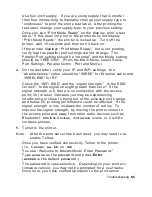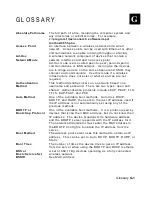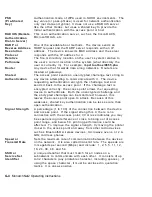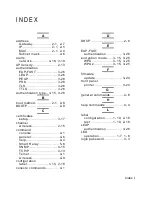
G-2
MonarchNet2 Operating Instructions
Channel or
RF Channel
You can select which channel your network devices use to
communicate. All devices must be on the same channel to
communicate in Ad-Hoc mode. Other radio devices such as
Bluetooth® wireless devices, microwave ovens, or 2.4-GHz
cordless phones may operate/interfere if they are on the same
channel as your network.
DHCP or
Dynamic Host
Configuration
Protocol
One of the available boot methods. It is a protocol that issues
IP addresses automatically within a specified range to devices
(such as printers) when they are first turned on. The device
keeps the IP address for a defined period of time set by your
System Administrator; however, a device could have a different
IP address every time it connects to the network.
EAP (Extensible
Authentication
Protocol)
Defines how to pass authentication information between the
device and authentication server. The authentication is
handled by the EAP type: FAST, TLS, TTLS, etc.
FAST (Flexible
Authentication
via Secure
Tunneling)
Cisco Systems® developed this authentication protocol. It
does not use certificates to authenticate, but a PAC (Protected
Access Credential), which is managed dynamically by the
server. The PAC is distributed one at a time to the client
manually or automatically.
Gatew ay
Allows connections (communications) between different
subnets on a network.
Infrastructure
Mode
Requires an access point to communicate with other devices
on the network. In infrastructure mode, wireless devices can
communicate with each other or with a wired network.
IP Address
An Internet Protocol identifier for a device on a network. It
consists of four 3-digit numeric fields, separated by periods.
Each number can be zero to 255. An IP address has two
components, the network address and the host address. Most
company networks have ranges for their IP addresses.
LAN or
Local Area
Netw ork
A computer network that connects personal computers,
workstations, servers, and printers. This allows each user on
the network the ability to share devices, such as printers, and
communicate with each other via email, etc. LANs can be
connected to each other by telephone lines or radio waves.
See
WLAN
.
LEAP
(Lightw eight
Extensible
Authentication
Protocol)
Cisco Systems® introduced this authentication protocol and
provides mutual authentication with unique WEP keys for each
user. New keys are issued based on a time limit. Changing
the WEP key time limits provides additional security.
Summary of Contents for Monarch 9860
Page 6: ...iv ...
Page 16: ...1 10 MonarchNet2 Operating Instructions ...
Page 34: ...2 18 MonarchNet2 Operating Instructions ...
Page 84: ...4 24 MonarchNet2 Operating Instructions ...
Page 100: ...6 8 MonarchNet2 Operating Instructions ...
Page 112: ...iv MonarchNet2 Operating Instructions ...
Page 113: ......
Page 114: ......











































